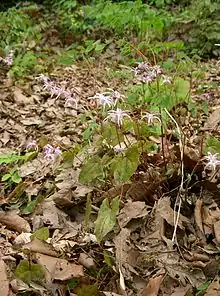| Epimedium grandiflorum | |
|---|---|
 | |
| Scientific classification | |
| Kingdom: | Plantae |
| Clade: | Tracheophytes |
| Clade: | Angiosperms |
| Clade: | Eudicots |
| Order: | Ranunculales |
| Family: | Berberidaceae |
| Genus: | Epimedium |
| Species: | E. grandiflorum |
| Binomial name | |
| Epimedium grandiflorum | |
| Synonyms[1] | |
| |

Epimedium grandiflorum, the large flowered barrenwort, or bishop's hat, is a species of flowering plant in the family Berberidaceae, native to Japan and Korea.[2]
Description
It is a deciduous perennial growing to 30 cm (12 in), with bright red stems with green heart-shaped leaves (copper-tinged when young) which are slightly hairy on the bottom. In spring it produces pink, white, yellow or purple long-spurred flowers.[3] The Latin specific epithet grandiflorum means large-flowered.[4]
Cultivation
Numerous cultivars have been selected for garden use, of which the following have gained the Royal Horticultural Society's Award of Garden Merit:[5]
Use
It is commonly packed in a capsule with other ingredients or sold as herbal flakes or powder with the name "horny goat weed".[8]
References
- ↑ "WFO Synonyms - E. grandiflorum". World Flora Online. Retrieved 25 September 2022.
- ↑ "Epimedium grandiflorum". Germplasm Resources Information Network. Agricultural Research Service, United States Department of Agriculture. Retrieved 25 September 2022.
- ↑ RHS A-Z encyclopedia of garden plants. United Kingdom: Dorling Kindersley. 2008. p. 1136. ISBN 978-1405332965.
- ↑ "Epimedium grandiflorum - Plant Finder". www.missouribotanicalgarden.org. Retrieved 2022-07-25.
- ↑ "AGM Plants - Ornamental" (PDF). Royal Horticultural Society. July 2021. p. 38. Retrieved 25 September 2022.
- ↑ "RHS - E. grandiflorum 'Akagi-Zakura'". Retrieved 25 September 2022.
- ↑ "RHS - E. grandiflorum 'Circe'". Retrieved 25 September 2022.
- ↑ "HORNY GOAT WEED: Uses, Side Effects, Interactions and Warnings - WebMD". www.webmd.com. Retrieved 2017-10-20.
External links
 Media related to Epimedium grandiflorum at Wikimedia Commons
Media related to Epimedium grandiflorum at Wikimedia Commons Data related to Epimedium grandiflorum at Wikispecies
Data related to Epimedium grandiflorum at Wikispecies